Translate this page into:
Measurement of arterial stiffness in subjects with and without renal disease: Are changes in the vessel wall earlier and more sensitive markers of cardiovascular disease than intima media thickness and pulse pressure?
Address for correspondence: Dr. Indranil Dasgupta, Renal Unit, Heartlands Hospital, Bordesley Green East, Birmingham, UK. E-mail: indranil.dasgupta@heartofengland.nhs.uk
This is an open-access article distributed under the terms of the Creative Commons Attribution-Noncommercial-Share Alike 3.0 Unported, which permits unrestricted use, distribution, and reproduction in any medium, provided the original work is properly cited.
This article was originally published by Medknow Publications & Media Pvt Ltd and was migrated to Scientific Scholar after the change of Publisher.
Abstract
There is increased cardiovascular (CV) mortality in subjects with chronic kidney disease (CKD). Arterial stiffness in these subjects is increased when compared to a healthy population. Markers of arterial stiffness and intima media thickness (IMT) are predictors of CV mortality. The aim of this study was to investigate whether there is any difference in markers of arterial stiffness and IMT between subjects with normal renal function and those with mild renal disease. The arterial distension waveform, IMT, diameter, and brachial blood pressure were measured to calculate Young's modulus (E) and elastic modulus (Ep) in the common carotid arteries of subjects with normal kidney function (estimated glomerular filtration rate [eGFR] >90) and those mild CKD (stage 2, eGFR 89–60). Data were available for 15 patients with normal kidney function and 29 patients with mild CKD. The subjects with mild CKD were older, but other co-variables were not significantly different. Both arterial wall stiffness parameters (E and Ep), but not IMT were significantly higher in the mild CKD group. Logistic regression demonstrated that only the arterial wall stiffness parameters (Ep and E) were independently associated with mild renal disease compared with normal, in a model adjusting for sex, age and diabetes and history of cardiovascular disease (CVD). E and Ep may be early markers of CVD in subjects with mild CKD that may manifest change before other more recognized markers such as IMT and pulse pressure.
Keywords
Arterial stiffness
atherosclerosis
chronic kidney disease
intima media thickness
Background
Chronic kidney disease (CKD) is associated with high cardiovascular (CV) morbidity and mortality. The risk increases exponentially with increasing severity of CKD.[1234] Subjects with CKD have been shown to have increased arterial stiffness.[5] Increased arterial stiffness and increased carotid intima media thickness (IMT) have both been shown to be independent predictors of both CV and all-cause mortality in these subjects.[6789] It is probable that cardiovascular disease (CVD) starts to develop earlier in CKD offering the possible benefit of early risk modification.
Most studies in renal patients were done using aortic pulse wave velocity, which is an indirect measure of arterial stiffness. Furthermore, the subjects in most of these studies had advanced CKD.[6789] Here, we have assessed arterial stiffness by directly examining the carotid artery using tissue Doppler imaging (TDI) and the IMT in the same subjects with mild renal disease. The aim is to assess whether there is any difference in directly measured arterial stiffness and IMT between those with normal subjects and those with mild CKD, and to investigate, which putative predictors of CV events – IMT or arterial stiffness - differ most between subjects with normal renal function and those with mild CKD.
Methods
Subjects
Subjects were recruited from nonrenal outpatient clinics at the Heart of England NHS Foundation Trust. These subjects were attending hospital with non-cardiovascular problems such as herniae, simple skin lesions, and benign urological disease. All participants were subject to similar scrutiny in order to determine their renal status. The patients were divided according to estimated glomerular filtration rate (eGFR) into normal kidney function (eGFR ≥90 ml/min/1.73 m2) and those with mild CKD (eGFR between 89 and 60 ml/min/1.73 m2).
All subjects recruited into the study provided fully informed written consent. Ethical approval was granted by Birmingham East District Research and Ethics Committee. All subjects completed a questionnaire regarding past medical history and medications used.
Intima media thickness measurement
Far wall IMT was calculated from the same segment of the left common carotid artery (CCA) in the same cineloop as arterial distension waveform (ADW) using an automated edge detection program examining the B-mode image (IMT plug-in, HDI-Lab, Philips Medical Systems, Bothell, WA, USA). This method is well-recognized and has been used in previous published research with good reproducibility.[1011] Mean IMT for the far wall in all frames across all cardiac cycles captured in the cineloop was used, in view of published advice that IMT changes across the cardiac cycle and that measurement of IMT in the far wall as opposed to the near wall is more accurate.[12]
Arterial distension waveform capture
This method has been described in detail previously,[13] and is in agreement with the standardization of subject conditions recommended by the Expert consensus document on arterial stiffness.[14] Briefly, all subjects were rested for 5 min prior to measurement, and were placed supine on an adjustable couch, with a pillow under their head to minimize movement. The artery was imaged longitudinally using the L12/5 linear array of an HDI 5000 ultrasound imaging system (Philips Medical Systems, Bothell, WA, USA), and scan-plane alignment was performed using B-mode imaging to ensure that echoes from the intima-media layers were clearly visible. TDI was enabled and real-time images collected over at least three cardiac cycles were saved to disc. The data were transferred off-line for analysis.
Arterial distension waveform analysis and calculation of indices of arterial stiffness
Indices of arterial stiffness can be divided into two types: Indices of “structural stiffness” and indices of “material stiffness”.[15] Indices of structural stiffness are descriptors of the overall stiffness of the wall of an artery, and describe the elastic behavior of the whole arterial wall at the point of measurement, such as the pressure strain elastic modulus (Ep).[16] Indices of material stiffness describe the physical properties of the substance that makes up the subject body such as Young's modulus (E). Ep requires measurement of the fractional arterial distension from diastole to systole, together with the corresponding blood pressures and is calculated by the following formula:
Ep = (∆p * d)/∆d
where d is diameter, ∆p is systolic minus diastolic pressure, and ∆d is the difference in diameter at systole and diastole. Calculation of E requires measurement of wall thickness as well and is given by:
E = (d/2h) * Ep
where h is the wall thickness.
After transfer of the raw cineloop to the personal computer, a commercial software analysis package (HDI-Lab, Philips Medical Systems, Bothell, WA, USA) was used to obtain wall distension waveforms from the TDI data. The core feature of this technique is that TDI data provide information on wall velocity as a function of time. Wall distension is then calculated by integration of velocity with respect to time. This is performed for each scan-line of the TDI image, providing some 40 measurements of the distension-time waveform over a 2 cm length of artery. The mean arterial diameter change (MADC) was calculated from all lines in all cardiac cycles in which the arterial diameter change was calculated by measuring the maximum excursion for each line and then taking the mean of all these values. E and Ep were calculated separately using MADC, arterial diameter, IMT, and pulse pressure (PP) data for the respective carotid artery.
Blood pressure measurement
Three blood pressure measurements in the right brachial artery using a Critikon automatic blood pressure manometer (GE Healthcare, Bucks, UK) were taken before, during and after the time the ADW was captured, whilst the patient remained supine. PP was calculated by subtracting diastolic from systolic blood pressure. Hypertension and hypercholesterolaemia were defined as history of taking anti-hypertensive medication and statin respectively.
Estimates of renal function
The absence of kidney disease was defined by the absence of proteinuria on dipstick test and by eGFR ≥90 ml/min/1.73 m2, demonstrated on samples taken within 6 months of participation in this study. The GFR was estimated from serum creatinine, using the modification of diet in renal disease study equation.[17] Serum creatinine was measured by a modified Jaffé test. For the purpose of this study, mild CKD was defined as eGFR between 60 and 89 ml/min/1.73 m2(CKD stage 2). Stages of CKD were defined according to the level of GFR as recommended by the National Kidney Foundation Kidney Disease Outcomes Quality Initiative clinical practice guidelines for CKD.[18]
Subjects were recruited and divided into two distinct groups: Normal renal function, (eGFR >90 ml/min/1.73 m2) and mild CKD (eGFR 89–60 ml/min/1.73 m2, CKD stage 2).
Statistical analysis
The median and range of E, Ep, and IMT over both groups were examined with box plots. Comparison on mean values was performed with Student's t-test after log transformation. Multiple regression analysis of the relationship between E, Ep, and IMT with eGFR was carried out, adjusting for age. All statistical calculations were performed using Stata 8.1 for Windows (STATA, Stata Corporation, College Station, TX, USA).
Results
We assessed elastic properties of the left CCA in 44 subjects, 15 with normal kidney function, and 29 with mild CKD. Subject demographics and coexisting morbidities are detailed in Table 1. There was no significant difference between the two groups in comorbidities. However, the mild CKD group was significantly older. Box plots of E, Ep, PP, and IMT against CKD group are shown in [Figures 1–3]. Both E and Ep were significantly increased in the early CKD group compared with the normal kidney function group. There was no difference between the groups in PP or IMT. Table 2shows the results.
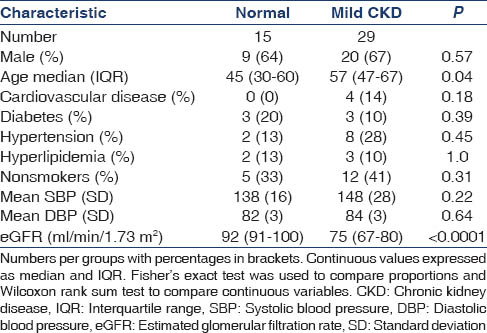
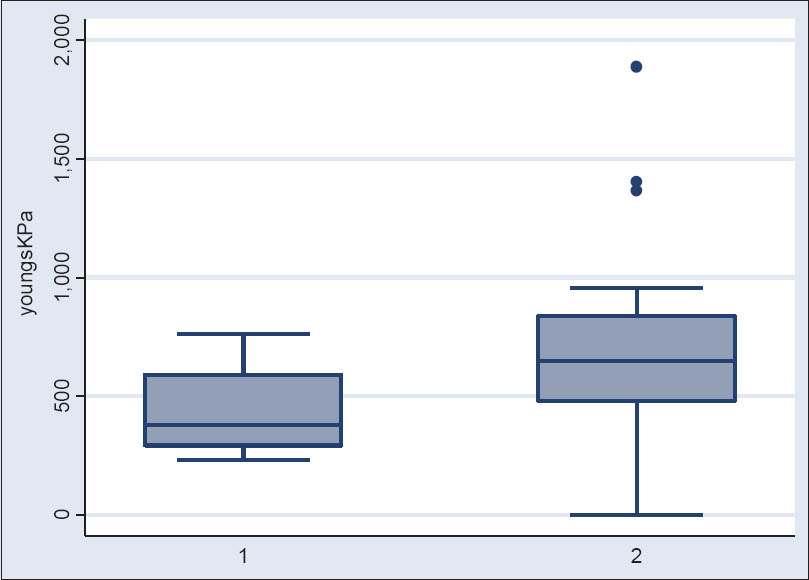
- Box plot of Eper chronic kidney disease stage group. CKD stage 1 and CKD stage 2 represented in order across x-axis. Escale on y-axis in KPa
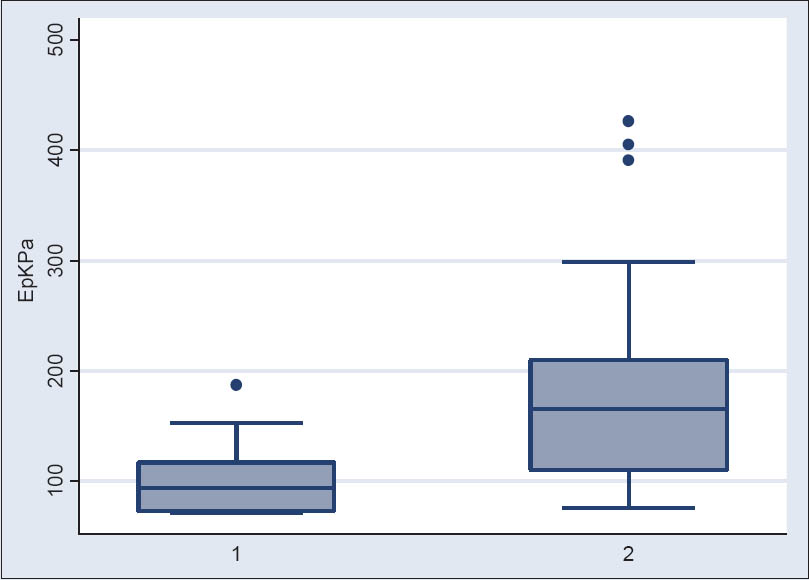
- Boxplot ofEp per chronic kidney disease (CKD) stage. Normal (1) and mild CKD (2) represented in order acrossx-axis.Epscale ony-axis in KPa
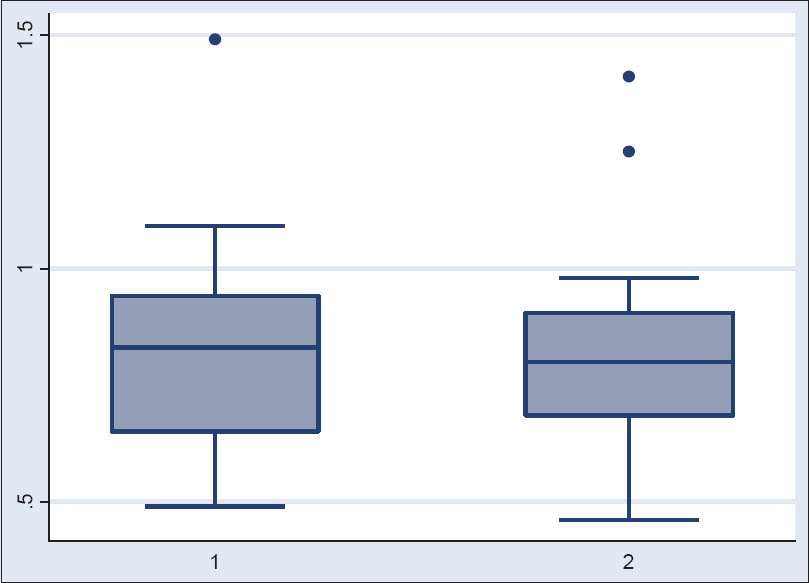
- Box plot of IMT per chronic kidney disease stage group. CKD stage 1 and CKD stage 2 represented in order across x-axisIMTscale on y-axis in mm

We used a multiple regression analysis to assess the association of E, Ep, PP, and IMT with eGFR. Both indices of arterial stiffness were significantly negatively associated with eGFR, while PP and IMT were not [Table 3]. In all cases, we used the same model adjusting for age, presence of any form of CVD, smoking status, and diabetes.
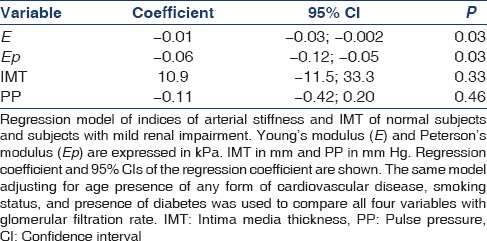
Discussion
In this study, investigating using TDI of carotid artery, we have shown that indices of arterial stiffness are significantly related to renal dysfunction. Furthermore, we have found that there is a significant difference in arterial stiffness between those with normal kidney function and those with mild CKD group. E and Ep were independent predictors of mild renal impairment in a logistic regression model adjusting for age, sex, diabetes, and CVD. IMT was found not to be significantly different in the same subjects.
The difference in E and Ep between normal and mild CKD groups suggests that that there is an increase in both the material and overall structural stiffness of the arterial wall early in the development of renal disease. This may occur before other markers of CVD are apparent such as increased IMT. This may be because the observed increase in the arterial wall stiffness in subjects with renal disease occurs due of different mechanisms from that found in a normal population. Putative mechanisms include changes in the quantity[19] and elasticity[20] of extracellular collagen together with medial calcification.[21]
Increase in arterial stiffness in CKD, assessed by pulse wave velocity, has been shown by others.[22232425] Most of these studies included patients with more advanced CKD. Moreover, in contrast to these studies, we carried out direct measurement of indices of arterial stiffness using TDI. We did not measure pulse wave velocity in our cohort which would be useful to compare.
Increased carotid IMT secondary to hypertension and wall stress has been noted in CKD patients,[19] but this may be a late change, as we did not find any significant increase in IMT in our study, which involved patients with normal kidney function and those with mild CKD (eGFR 89–60 ml/min/1.73 m2). Similar observation has been made by a Japanese study.[26] However, in contrast to our study, this study defined kidney disease as eGFR <60 ml/min/1.73 m2 and/or presence of proteinuria. While in the absence of proteinuria data (or measured GFR) the diagnosis of mild CKD is less secure, it is interesting to note that the observations are similar in the two studies.
We used carotid IMT as an estimation of the arterial wall thickness to calculate E. However, IMT is not a measurement of entire arterial wall thickness and represents the intima and the tunica media of the carotid artery.[27] Both Pignoli and Wong have demonstrated that ultrasonic estimation of IMT was accurate when compared to histological verification, as long as the far wall of the insonated artery was examined, a practice that we have followed. Wong suggested that the adventitial layer contributes 25% of the thickness of carotid arterial walls by histological analysis, but that the adventitial layer is not recognized by ultrasound consistently or accurately.[2829] Clearly the adventitial layer of an artery has important mechanical properties. In a study of human femoral arteries, Schulze-Bauer estimated that the adventitial layer carried approximately 25% of the arterial wall load.[30] In line with previous studies of this nature we have not attempted to correct for the lack of measurement of the adventitial layer in our estimation of wall thickness.[31] We believe this does not alter our conclusions as we used the same measurement method and calculations for all subjects and a change in wall thickness of 25% or less would not alter the statistical significance of our results. Furthermore, it is widely accepted that most structural changes in the arterial wall in response to ageing and disease are believed to be in the intima and media.[3233]
A recent population based study, involving subjects with stages 2 and 3 CKD, has shown that carotid IMT and Young's modulus, along with carotid diameter and PP, increase with lower eGFR. They also found a similar association with urinary albumin excretion even below the conventional microalbuminuria range and this was independent of eGFR. On the basis of these findings, they concluded that both eGFR and albuminuria should be interpreted as an independent risk factors for CVD.[34] Our observations support this view and that changes of arterial stiffness take place at a very early stage in the natural history of CKD, even before CKD becomes clinically significant.
Our study suggests that changes in arterial stiffness may be more sensitive markers of early CVD in subjects with mild renal disease. However, the numbers involved in this study are small and as such this needs to be confirmed in larger longitudinal studies.
Conclusions
This study, using TDI of CCA, has shown a statistically significant increase in both material and structural arterial stiffness as measured by E and Ep, respectively in subjects with mild renal disease compared with those with normal renal function. Our findings suggest that the changes in the arterial wall occur very early in the course of CKD and may explain, at least in part, the high CV risk associated with even mild to moderate CKD.
Source of Support: Nil
Conflict of Interest: None declared.
References
- Accelerated atherosclerosis in prolonged maintenance hemodialysis. N Engl J Med. 1974;290:697-701.
- [Google Scholar]
- Cardiovascular disease and chronic renal disease: A new paradigm. Am J Kidney Dis. 2000;35(Suppl 1):S117-31.
- [Google Scholar]
- Clinical epidemiology of cardiovascular disease in chronic renal disease. Am J Kidney Dis. 1998;32:S112-9.
- [Google Scholar]
- Chronic kidney disease and the risks of death, cardiovascular events, and hospitalization. N Engl J Med. 2004;351:1296-305.
- [Google Scholar]
- Arterial stiffness in chronic kidney disease: Causes and consequences. Heart. 2010;96:817-23.
- [Google Scholar]
- Stepwise increase in arterial stiffness corresponding with the stages of chronic kidney disease. Am J Kidney Dis. 2005;45:494-501.
- [Google Scholar]
- Impact of aortic stiffness on survival in end-stage renal disease. Circulation. 1999;99:2434-9.
- [Google Scholar]
- Diabetes mellitus, aortic stiffness, and cardiovascular mortality in end-stage renal disease. J Am Soc Nephrol. 2001;12:2117-24.
- [Google Scholar]
- Prognostic significance of arterial stiffness measurements in end-stage renal disease patients. Curr Opin Nephrol Hypertens. 2002;11:629-34.
- [Google Scholar]
- Does renal failure cause an atherosclerotic milieu in patients with end-stage renal disease? Am J Med. 2001;110:198-204.
- [Google Scholar]
- The relative importance of vascular structure and function in predicting cardiovascular events. J Am Coll Cardiol. 2004;43:616-23.
- [Google Scholar]
- A reproducibility study of a TDI-based method to calculate indices of arterial stiffness. Ultrasound Med Biol. 2008;34:215-20.
- [Google Scholar]
- Expert consensus document on arterial stiffness: Methodological issues and clinical applications. Eur Heart J. 2006;27:2588-605.
- [Google Scholar]
- Experimental approaches on measuring the mechanical properties and constitutive laws of arterial walls. J Biomech Eng. 1993;115:481-8.
- [Google Scholar]
- A more accurate method to estimate glomerular filtration rate from serum creatinine: A new prediction equation. Modification of Diet in Renal Disease Study Group. Ann Intern Med. 1999;130:461-70.
- [Google Scholar]
- K/DOQI. NKF. Part 4. Definition and classification of stages of chronic kidney disease. Am J Kidney Dis. 2002;39(Suppl 1):S46-75.
- [Google Scholar]
- Mechanisms, pathophysiology, and therapy of arterial stiffness. Arterioscler Thromb Vasc Biol. 2005;25:932-43.
- [Google Scholar]
- Alterations in nonenzymatic biochemistry in uremia: Origin and significance of “carbonyl stress” in long-term uremic complications. Kidney Int. 1999;55:389-99.
- [Google Scholar]
- Vascular calcification in long-term haemodialysis patients in a single unit: A retrospective analysis. Nephron. 1997;77:37-43.
- [Google Scholar]
- Creatinine clearance, pulse wave velocity, carotid compliance and essential hypertension. Kidney Int. 2001;59:1834-41.
- [Google Scholar]
- Association between arterial stiffness and estimated glomerular filtration rate in the Japanese general population. J Atheroscler Thromb. 2009;16:840-5.
- [Google Scholar]
- Association of serum cystatin C with pulse wave velocity, but not pressure wave reflection, in subjects with normal renal function or mild chronic kidney disease. Am J Hypertens. 2010;23:967-73.
- [Google Scholar]
- Chronic kidney disease is associated with increased carotid artery stiffness without morphological changes in participants of health check-up programs. Atherosclerosis. 2010;213:306-10.
- [Google Scholar]
- Carotid artery intima-media thickness as an indicator of generalized atherosclerosis. J Intern Med. 1994;236:567-73.
- [Google Scholar]
- Intimal plus medial thickness of the arterial wall: A direct measurement with ultrasound imaging. Circulation. 1986;74:1399-406.
- [Google Scholar]
- Ultrasonic-pathological comparison of the human arterial wall. Verification of intima-media thickness. Arterioscler Thromb. 1993;13:482-6.
- [Google Scholar]
- Mechanics of the human femoral adventitia including the high-pressure response. Am J Physiol Heart Circ Physiol. 2002;282:H2427-40.
- [Google Scholar]
- In vivo human brachial artery elastic mechanics: Effects of smooth muscle relaxation. Circulation. 1999;100:41-7.
- [Google Scholar]
- Modelling of cardiovascular system: Development of a hybrid (numerical-physical) model. Int J Artif Organs. 2003;26:1104-14.
- [Google Scholar]
- Age-related changes in composition and mechanical properties of the tunica media of the upper thoracic human aorta. Arteriosclerosis. 1983;3:64-76.
- [Google Scholar]
- Estimated glomerular filtration rate and urinary albumin excretion are independently associated with greater arterial stiffness: The Hoorn Study. J Am Soc Nephrol. 2007;18:1942-52.
- [Google Scholar]







